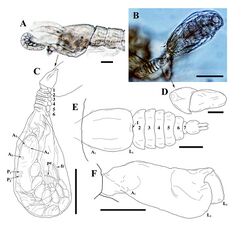Biology:Tantulocarida
| Tantulocarida | |
|---|---|

| |
| Microdajus sp. | |
| Scientific classification | |
| Domain: | Eukaryota |
| Kingdom: | Animalia |
| Phylum: | Arthropoda |
| Superclass: | Multicrustacea |
| Class: | Tantulocarida G. A. Boxshall & R. J. Lincoln, 1983 [1] |
| Families | |
Tantulocarida is a highly specialised group of parasitic crustaceans that consists of about 33 species, treated as a class in superclass Multicrustacea. They are typically ectoparasites that infest copepods, isopods, tanaids, amphipods and ostracods.[2][3]
Description
Eyes are completely absent.[4]
The tantulus larvae has a head with a ventral oral disc but no appendages, a six-segmented thorax with six pairs of legs, and a limbless abdomen consisting of one to six segments in addition to a telson.[5]
Body length
Members of this subclass are minute – less than 0.3 millimetres (0.012 in) in length and have a dramatic reduction in body form compared to other crustaceans, with an unsegmented, sac-like thorax and a much reduced abdomen.[6] One tantulocarid species, Tantulacus dieteri, is the world's smallest arthropod, with a total body length of only 85 micrometres (0.0033 in).[7]
Life cycle
The tantulocarid life cycle is unique among crustaceans. The tantulus larva transforms directly from a non-feeding (lecithotrophic) and free-swimming organism into a parasite without any instars. When entering the parasitic stage much of the body, such as the muscles, degenerates, even if the body itself becomes bigger. As a parasite it is permanently attached to its host, and after piercing its host's cuticle with an unpaired stylet, a rootlet system used to absorb nutrients enters through the hole and grow into the host’s tissue. The adult form developes inside the larva, and can become either a sac-like parthenogenetic female, or a fully developed free-living, non-feeding and sexually-reproducing male or female.[8][9][10][11][12] The eggs inside the parthenogenetic female are eventually released as fully developed tantulus larvae. The finding of what appears to be a benthic non-feeding nauplius larva suggests that eggs produced by sexual females hatch as nauplii instead of tantulus larvae. Both the parthenogenetic and sexual females are semelparous.[13]
Classification
Five families are recognised:[14]
|
Basipodellidae Boxshall & Lincoln, 1983:[15]
Doryphallophoridae Huys, 1991:[16]
Microdajidae Boxshall & Lincoln, 1987:[17]
|
Cumoniscidae Nierstrasz & Brender à Brandis, 1923 (formerly family Deoterthridae:[18]
Onceroxenidae Huys, 1991:[19]
|
References
- ↑ "Tantulocarida". Integrated Taxonomic Information System. https://www.itis.gov/servlet/SingleRpt/SingleRpt?search_topic=TSN&search_value=621147.
- ↑ "WoRMS - World Register of Marine Species - Tantulocarida". http://www.marinespecies.org/aphia.php?p=taxdetails&id=1083.
- ↑ Geoffrey A. Boxshall & Roger J. Lincoln (February 1983). "Tantulocarida, a new class of Crustacea ectoparasitic on other crustaceans". Journal of Crustacean Biology 3 (1): 1–16. doi:10.2307/1547849.
- ↑ Oakley, T. H.; Cunningham, C. W. (2002). "Molecular phylogenetic evidence for the independent evolutionary origin of an arthropod compound eye". Proceedings of the National Academy of Sciences of the United States of America 99 (3): 1426–1430. doi:10.1073/pnas.032483599. PMID 11818548. Bibcode: 2002PNAS...99.1426O.
- ↑ Multicellular Animals: Volume II: The Phylogenetic System of the Metazoa
- ↑ "Tantulocarida". AccessScience Encyclopedia. McGraw-Hill. http://www.accessscience.com/abstract.aspx?id=677750. Retrieved 2016-09-10.
- ↑ Inga Mohrbeck, Pedro Martínez Arbizu & Thomas Glatzel (October 2010). "Tantulocarida (Crustacea) from the Southern Ocean deep sea, and the description of three new species of Tantulacus Huys, Andersen & Kristensen, 1992". Systematic Parasitology 77 (2): 131–151. doi:10.1007/s11230-010-9260-0. PMID 20852984.
- ↑ G. A. Boxshall & R. J. Lincoln (June 11, 1987). "The life cycle of the Tantulocarida (Crustacea)". Philosophical Transactions of the Royal Society B 315 (1173): 267–303. doi:10.1098/rstb.1987.0009.
- ↑ Anatomy of the free tantulus larva (Crustacea: Tantulocarida) studied with confocal laser scanning microscopy: An extreme case of miniatuarisation in the Arthropoda
- ↑ Itoitantulus misophricola gen. et sp. nov.: First Record of Tantulocarida (Crustacea: Maxillopoda) in the North Pacific Region
- ↑ Tantulocaridan Life Cycle: the Circle Closed? - Oxford Academic
- ↑ Anatomy of the Tantulocarida: first results obtained using TEM and CLSM. Part I: tantulus larva - GfBS
- ↑ Atlas of Crustacean Larvae
- ↑ WoRMS. "Tantulocarida". http://www.marinespecies.org/aphia.php?p=taxdetails&id=1083.
- ↑ Geoff Boxshall (August 20, 2008). "Basipodellidae". in T. Chad Walter & Geoff Boxshall. World Copepoda database. World Register of Marine Species. http://www.marinespecies.org/aphia.php?p=taxdetails&id=136591. Retrieved 2016-09-10.
- ↑ Geoff Boxshall (August 20, 2008). "Doryphallophoridae". in T. Chad Walter & Geoff Boxshall. World Copepoda database. World Register of Marine Species. http://www.marinespecies.org/aphia.php?p=taxdetails&id=136593. Retrieved 2016-09-10.
- ↑ Geoff Boxshall (August 20, 2008). "Microdajidae". in T. Chad Walter & Geoff Boxshall. World Copepoda database. World Register of Marine Species. http://www.marinespecies.org/aphia.php?p=taxdetails&id=136594. Retrieved 2016-09-10.
- ↑ WoRMS. "Cumoniscidae Nierstrasz & Brender à Brandis, 1923". http://www.marinespecies.org/aphia.php?p=taxdetails&id=1063847.
- ↑ Geoff Boxshall (2012). "Onceroxenidae". World of Copepods database. World Register of Marine Species. http://www.marinespecies.org/aphia.php?p=taxdetails&id=136595.
External links
Wikidata ☰ Q2340012 entry
 |

